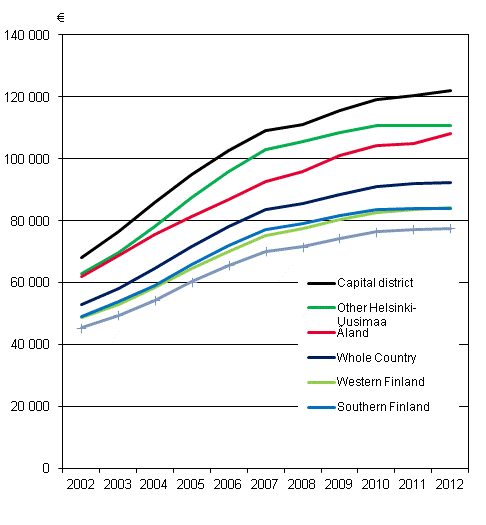Published: 26 June 2013
Average housing loan of households with housing loans was EUR 92,370 in 2012
According to Statistics Finland's statistics on indebtedness, the average housing loan of household-dwelling units with housing loans in the Greater Helsinki area was EUR 121,950, i.e. one-third more than for all household dwelling-units with housing loans. Housing loans were lowest in Northern and Eastern Finland, EUR 77,560 per indebted household. The average housing loans have grown by 75 per cent since 2002. The loans have grown most, by 79 per cent, in the Greater Helsinki area.
Average housing loans of household-dwelling units with housing loans by major region in 2002 to 2012, at 2012 prices

One-third of all household-dwelling units, or 869,800, had housing loans. Housing loans were most frequent among household-dwelling units in the 35 to 44 age group of whom 61 per cent had housing loans. Among household-dwelling units in the 25 to 34 and 45 to 54 age groups, nearly one-half had housing loans. Household-dwelling units in the 25 to 34 age group had the largest housing loans, amounting to EUR 122,180 per household-dwelling unit with a housing loan. However, household-dwelling units in the 35 to 44 age group were the most indebted, because, in addition to housing loans, they often had other debts taken out for consumption and purchases.
There were a total of 120,800 household-dwelling units with more than EUR 200,000 in debt, which represents nine per cent of all indebted household-dwelling units. Two-thirds of such household-dwelling units were in the 25 to 44 age group and good one-fifth in the 45-54 age group. Persons under the age of 25 and pensioners seldom have debts of this size. Of the 158,500 household-dwelling units with housing loans in Greater Helsinki area, one-half had a housing loan of at least EUR 100,000 and 17 per cent over EUR 200,000. Such large housing loans were nearly as common elsewhere in the major region of Helsinki-Uusimaa.
Slightly over one-half of household-dwelling units, i.e. 1,394,000, had debts in 2012. Household-dwelling units’ outstanding debts totalled EUR 108.7 billion, of which EUR 80.3 billion were housing loans. The business loans taken out by 78,600 household-dwelling units totalled EUR six billion and the study loans of 285,500 household dwelling-units amounted to EUR 1.6 billion. A total of EUR 20.8 billion had been taken out in other debts for consumption and larger purchases by 852,000 household-dwelling units. 1) In total, debts grew by three per cent and housing loans by 4.7 per cent from the previous year.
Housing loans have grown faster than other debts. From 2002, housing loans have grown in real terms by 130 per cent, while all debts have doubled over the same period. The fastest growth in housing loans was witnessed at the beginning of last decade when they grew by over ten per cent per year. Since 2007, the growth rate has slowed down but has still been quicker than for other debts.
Household-dwelling units' interest expenses totalled EUR 2.5 billion in 2012. Interest expenses decreased by good five per cent from the year before. In 2012, household-dwelling units paid in real terms eight per cent less in interest expenses than in 2002 even though their debts had doubled over the same period.
1) Other debts for 2012 are not comparable with the figures for previous years because the Tax Administration has changed its reporting guidelines for them.
Source: Indebtedness 2012. Statistics Finland
Inquiries: Timo Matala 09 1734 3422, toimeentulo@stat.fi
Director in charge: Riitta Harala
- Tables
-
Tables in databases
Pick the data you need into tables, view the data as graphs, or download the data for your use.
Updated 26.6.2013
Official Statistics of Finland (OSF):
Indebtedness [e-publication].
ISSN=2489-3285. 2012. Helsinki: Statistics Finland [referred: 19.4.2024].
Access method: http://www.stat.fi/til/velk/2012/velk_2012_2013-06-26_tie_001_en.html

